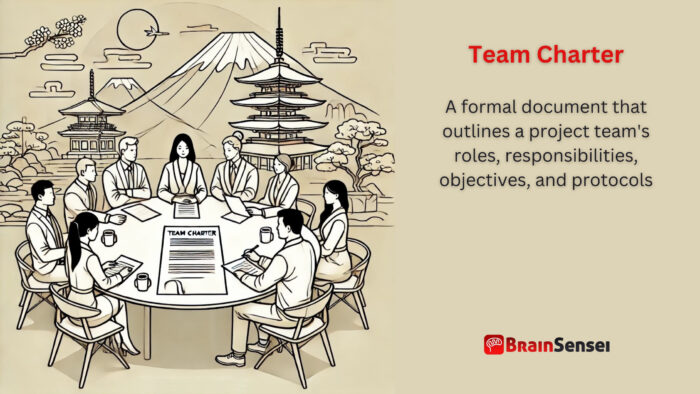
Team Charter
What is a Team Charter?
A team charter, a formal document outlining a project team’s roles, responsibilities, objectives, and protocols, is a powerful tool that provides a clear roadmap for team collaboration. It ensures everyone understands their tasks, makes informed decisions, and enhances project productivity. A well-defined team charter is key to successful project management, keeping teams aligned and minimizing confusion.
Key Takeaways
- Clarifies team roles, responsibilities, and objectives
- Establishes guidelines for communication and decision-making
- Aligns team members with project goals
- Serves as a reference point to resolve conflicts
- Enhances accountability and team cohesion
Understanding the Team Charter
How It Works
The project team typically develops the team charter during the project initiation phase, with input from all team members and stakeholders. This collaborative effort results in a shared agreement that guides team interactions and decisions. Key components include the project’s purpose, team structure, communication plan, and conflict resolution strategies.
- Purpose Statement: Defines the project’s goals and objectives.
- Roles and Responsibilities: Specifies each member’s duties and expectations.
- Communication Plan: Outlines communication methods and frequency.
- Decision-Making Guidelines: Clarifies the decision-making process and who has authority.
- Conflict Resolution Plan: Establishes procedures for resolving disputes.
Notes
- The project team regularly reviews the team charter to ensure its continued relevance and effectiveness. This practice helps adapt the charter to changing project dynamics and maintain its value throughout its lifecycle.
- Involving team members in its creation fosters ownership and commitment.
- Clearly defined responsibilities reduce overlap and confusion.
- The document should be accessible to all team members.
- Adjustments may be necessary as project dynamics evolve.
Related Terms
- Project Charter: A broader document outlining the project’s objectives, scope, and stakeholders.
- Roles and Responsibilities Matrix (RACI): A tool for defining who is Responsible, Accountable, Consulted, and Informed.
- Communication Plan: A plan detailing how to share project information.
- Stakeholder Register: A document listing all stakeholders and their involvement.
- Team Collaboration Tools: Software tools that support team communication and project tracking.
Examples of Team Charters in Different Industries
Manufacturing Industry
A manufacturing firm implementing a new production line creates a team charter to define roles across operations, engineering, and logistics. The document includes safety protocols, quality standards, and communication channels, ensuring streamlined production. The manufacturing team charter outlines specific responsibilities for each team member. For instance, the operations manager oversees production schedules, while the engineering team ensures equipment functionality. They scheduled regular meetings to review progress and address issues proactively. The charter also includes a section on lean manufacturing principles, promoting efficiency and waste reduction. By defining these elements upfront, the company successfully launches the new production line ahead of schedule and under budget.
In another case, a global automotive manufacturer uses a team charter to manage a new assembly line in a foreign market. The document addresses cultural differences and establishes protocols for communication between local and international staff. This proactive approach helps mitigate misunderstandings and fosters a collaborative environment.
Healthcare Industry
A hospital launches an electronic health records (EHR) system. The team charter clarifies the roles of IT staff, medical professionals, and administrative personnel. It establishes data handling, training, and system integration guidelines to ensure smooth adoption. The charter details protocols for data privacy and compliance with healthcare regulations like HIPAA. It also includes a staff training plan to ensure the new system’s practical use. The team scheduled regular review meetings to address technical issues and gather user feedback.
In another scenario, a healthcare network implements a telemedicine platform. The team charter specifies responsibilities for developing the software, training clinicians and promoting the service to patients. It also outlines performance metrics to assess the platform’s success. As a result, the staff rapidly adopted the telemedicine initiative, reducing patient wait times and improving access to care.
Government Sector
A municipal government develops a team charter for a community development project. The document specifies roles for planners, contractors, and community representatives, along with public engagement and budget tracking protocols. The charter includes a detailed timeline with milestones for key activities such as zoning approvals, public consultations, and infrastructure development. Clear communication guidelines help streamline interactions between departments.
Additionally, a national government agency uses a team charter to manage a countrywide digital transformation initiative. The charter defines roles for various agencies, establishes data-sharing protocols, and outlines cybersecurity measures. By adhering to the charter, the project achieves its objectives within the allocated timeframe and budget, demonstrating the value of structured collaboration in large-scale projects.
Use Cases of Team Charter in Different Regions
United States (Agile Software Development)
A Silicon Valley tech company uses a team charter to manage a new software release. The charter helps align developers, designers, and marketers with sprint goals, facilitating efficient collaboration in a fast-paced environment. The charter includes specific guidelines for task allocation, communication channels, and sprint goals. The team holds daily stand-up meetings and retrospective sessions to ensure continuous improvement. By clearly defining each role and expectation, the team delivers the software product on time and meets all client requirements.
Another example from the United States is a financial services firm implementing a new customer relationship management (CRM) system. The team charter outlines the roles of IT specialists, customer service representatives, and project managers. It specifies data management protocols and system training procedures, ensuring a smooth transition to the new platform.
Germany (Renewable Energy Project)
A German wind energy company employs a team charter to guide a cross-functional team. The document outlines procedures for site selection, equipment installation, and regulatory compliance, ensuring timely project completion. The team charter also addresses cross-cultural collaboration, as the company partners with international suppliers. It includes guidelines for multilingual communication, regular performance reviews, and joint problem-solving sessions.
In another case, a German logistics firm uses a team charter to streamline operations at a new distribution center. The document clarifies warehouse roles, delivery schedules, and quality control protocols. Regularly updated performance metrics help the team identify areas for improvement, enhancing operational efficiency.
Japan (Construction Project)
A Tokyo-based construction firm uses a team charter for a high-rise development. The charter defines roles for architects, contractors, and safety officers and promotes adherence to stringent safety standards and project timelines. It also incorporates the principles of kaizen, emphasizing continuous improvement. They regularly scheduled safety drills, progress meetings, and feedback sessions to maintain high performance standards.
A Japanese telecommunications company also adopted a team charter for a nationwide network upgrade. The document specifies tasks for engineering teams, regulatory compliance officers, and customer support staff. Precisely allocating responsibilities ensures the project proceeds without delays despite its technical complexity and broad geographical scope.
Best Practices for Team Charter Implementation
Successfully implementing a team charter requires strategic planning, active participation from all stakeholders, and continuous monitoring. Here are essential best practices to ensure effective implementation:
Involve the Entire Team from the Start
Engaging all team members in the charter creation process fosters a sense of ownership and accountability. When everyone understands the purpose and content of the charter, they are more likely to adhere to its guidelines.
Define Clear, Measurable Objectives
Objectives should align with the project’s goals and be specific, measurable, achievable, relevant, and time-bound (SMART). Clear objectives help team members focus their efforts and accurately measure progress.
Establish Robust Communication Channels
Effective communication is critical for team success. The charter should specify communication tools, meeting schedules, and reporting structures to avoid misunderstandings and ensure consistent information flow.
Clarify Roles and Responsibilities
Ambiguity about responsibilities can cause delays and conflicts. The team charter should outline each member’s duties, decision-making authority, and performance expectations. Using tools like the RACI matrix can provide additional clarity.
Develop a Conflict Resolution Strategy
Conflicts are inevitable in team settings. The charter should include protocols for constructively addressing disagreements, promoting collaboration, and maintaining team cohesion.
Regularly Review and Update the Charter
Projects evolve, and the team charter should adapt accordingly. Schedule periodic reviews to assess its effectiveness, address new challenges, and incorporate lessons learned.
Align the Charter with Organizational Policies
Ensure the team charter supports broader organizational goals and complies with internal policies and industry standards.
By following these best practices, teams can create a solid foundation for successful collaboration, minimize risks, and enhance project outcomes.
Common Mistakes and Issues
Creating and maintaining an effective team charter requires ongoing effort, and certain pitfalls can undermine its success. One common mistake is treating the team charter as a static document. As the project evolves, roles, goals, and processes may shift, necessitating updates to the charter. Failure to revise the document regularly can lead to misaligned efforts and confusion about responsibilities.
Another significant issue is insufficient team involvement during the charter development process. If a project excludes team members, they may feel disengaged and less committed to the document’s guidelines. Involving the team from the start encourages ownership and accountability.
Vague or ambiguous role definitions also pose a challenge. If team members do not clearly outline their responsibilities, they may duplicate efforts or neglect essential tasks. For example, a project team in a marketing firm faced delays and missed deadlines because they did not assign content creation responsibilities.
Communication breakdowns can further impede project success. A charter that lacks detailed communication protocols may result in inconsistent information flow, misunderstandings, and missed updates. Specifying tools, channels, and frequency of communication is critical for smooth collaboration.
Lastly, neglecting to align the team charter with organizational objectives can create disjointed efforts. The charter should reflect broader company goals and adhere to established policies. By avoiding these pitfalls and maintaining an adaptable, transparent, and inclusive team charter, teams can enhance their efficiency, cohesion, and project outcomes.
Frequently Asked Questions (FAQs)
What is the primary purpose of a team charter?
The primary purpose is to document team roles, responsibilities, goals, and communication protocols to facilitate efficient collaboration.
Who should create the team charter?
Typically, the project manager leads the creation process, with input from team members and stakeholders, to ensure relevance and buy-in.
How often should a team charter be updated?
The project team should review and update it whenever significant project changes occur.
What are the key components of a team charter?
Essential components include a purpose statement, roles and responsibilities, communication plan, decision-making guidelines, and conflict resolution strategies.
How does a team charter benefit virtual teams?
It provides clear communication guidelines and protocols, crucial for teams working remotely across different time zones.
Additional Resources
Preparing for a PMI certification?
- Exam Prep Courses: PMP®, CAPM®, and PMI-ACP®
- Exam Simulators: PMP®, CAPM®, PMI-ACP®, PMI-PBA®, PMI-RMP®, PMI-SP®, PgMP®, and PfMP®
- Professional Development Units (PDUs): 15, 30, and 60 PDU Bundles



